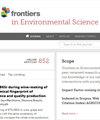对农业景观中地表地形和表土颗粒组成变化的长期评估
IF 3.3
3区 环境科学与生态学
Q2 ENVIRONMENTAL SCIENCES
引用次数: 0
摘要
了解地形和表土颗粒组成的长期变化对于农业景观的管理至关重要,尤其是在易受风蚀的地区。本研究调查了斯洛伐克西南部农业景观中地形和表土颗粒组成的长期变化。为了分析地形随时间的变化,我们使用了高精度定位测量和机载激光扫描技术,创建了 2011 年、2017 年和 2020 年的数字地形模型(DTM)。为了评估土壤颗粒成分的变化,我们对三个不同时期采集的土壤样本进行了粒度分析:M1(1961-1970 年)、M2(2009-2015 年)和 M3(2015-2016 年)。我们评估了土壤质地的变化,以了解风蚀对土壤成分的影响。此外,还通过比较堆积和放缩过程分析了防风林的影响。结果表明,在研究期间,地形和土壤质地都发生了显著变化。DTM 显示出积聚和放缩过程的明显差异,突出了受风蚀影响的区域。土壤样本比较显示,主要土壤类型从壤土和粘壤土转变为淤泥质壤土,突出表明了风蚀的影响。分析表明,粘土和淤泥的含量减少,而沙子的含量增加,这表明风造成了土壤退化。防风林的存在降低了风速,促进了土壤积累,稳定了上风 80 米和下风 20 米的地形,从而在减少土壤侵蚀方面发挥了重要作用。这项研究强调了气候和风力因素在塑造地形和土壤特性方面的复杂相互作用,并强调了防风林在农业景观中的长期保护作用。我们的研究结果表明,风蚀会显著改变土壤质地,从而影响农业生产率。然而,事实证明,防风林是减少土壤侵蚀和保持土壤质量的有效措施。本文章由计算机程序翻译,如有差异,请以英文原文为准。
Long-term evaluation of surface topographic and topsoil grain composition changes in an agricultural landscape
Understanding long-term changes in topography and topsoil grain composition is crucial for the management of agricultural landscapes, especially in areas prone to wind erosion. This study investigates long-term changes in topography and topsoil grain composition within an agricultural landscape in south-western Slovakia. To analyse topographic changes over time, we used high-precision positioning measurements and airborne laser scanning to create digital terrain models (DTM) for the years 2011, 2017 and 2020. To assess changes in soil grain composition, we performed grain size analyses on soil samples collected during three different periods: M1 (1961–1970), M2 (2009–2015) and M3 (2015–2016). Changes in soil texture were evaluated to understand the impact of wind erosion on soil composition. The influence of windbreaks was also analysed by comparing the accumulation and deflation processes. The results showed significant changes in both topography and soil texture over the study period. The DTMs showed marked differences in the accumulation and deflation processes, highlighting areas affected by wind erosion. Comparisons of soil samples showed a shift in dominant soil types from loam and clay loam to silty loam, highlighting the effects of wind erosion. Analysis revealed a decrease in clay and silt content and an increase in sand content, indicating wind-induced soil degradation. The presence of windbreaks played a crucial role in reducing soil erosion by reducing wind speed, promoting soil accumulation and stabilising the landscape up to 80 m windward and 20 m leeward. The study highlights the complex interplay of climate and wind factors in shaping topography and soil properties and emphasises the protective role of windbreaks in agricultural landscapes over time. Our results show that wind erosion significantly alters soil texture, which can affect agricultural productivity. However, windbreaks have proven to be an effective measure in reducing soil erosion and maintaining soil quality.
求助全文
通过发布文献求助,成功后即可免费获取论文全文。
去求助
来源期刊

Frontiers in Environmental Science
Environmental Science-General Environmental Science
CiteScore
4.50
自引率
8.70%
发文量
2276
审稿时长
12 weeks
期刊介绍:
Our natural world is experiencing a state of rapid change unprecedented in the presence of humans. The changes affect virtually all physical, chemical and biological systems on Earth. The interaction of these systems leads to tipping points, feedbacks and amplification of effects. In virtually all cases, the causes of environmental change can be traced to human activity through either direct interventions as a consequence of pollution, or through global warming from greenhouse case emissions. Well-formulated and internationally-relevant policies to mitigate the change, or adapt to the consequences, that will ensure our ability to thrive in the coming decades are badly needed. Without proper understanding of the processes involved, and deep understanding of the likely impacts of bad decisions or inaction, the security of food, water and energy is a risk. Left unchecked shortages of these basic commodities will lead to migration, global geopolitical tension and conflict. This represents the major challenge of our time. We are the first generation to appreciate the problem and we will be judged in future by our ability to determine and take the action necessary. Appropriate knowledge of the condition of our natural world, appreciation of the changes occurring, and predictions of how the future will develop are requisite to the definition and implementation of solutions.
Frontiers in Environmental Science publishes research at the cutting edge of knowledge of our natural world and its various intersections with society. It bridges between the identification and measurement of change, comprehension of the processes responsible, and the measures needed to reduce their impact. Its aim is to assist the formulation of policies, by offering sound scientific evidence on environmental science, that will lead to a more inhabitable and sustainable world for the generations to come.
 求助内容:
求助内容: 应助结果提醒方式:
应助结果提醒方式:


